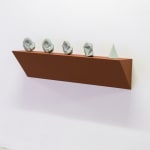 Exhibition view, Verweile doch! Du bist so schön! (2019)
Exhibition view, Verweile doch! Du bist so schön! (2019)
Sybren Renema
These fossils are made using a 3D printer, which printed 5 different shapes, each of which has been cast 5 times. Between the five shapes, we see the evolution of the object from pyramid to ammonite. If we follow this evolution the other way, we see an abstraction from ammonite to pyramid. The 5 shapes were based on the way in which a 3D model translates shapes into triangles. By cutting down the amount of triangles with 75% every time, five steps were needed to go from high-res object to pyramid, which is the smalles 3D shape when it comes to amount of triangles.
It is glazed with a glaze known as celadon. Celadon ware is highly valued in China, where it originates and is connected with jade. The process of glazing with celadon is a bit fickle, with craques and colour differences being some of the possible and sometimes desired effects. Because of the impossibility of controling celadon, it seemed a logical material to use on a piece about evolution. The choice for celadon also ties this work firmly with the ceramic tradition. Finally, the blueish green glaze can be said to be reminiscent of water, mirroring the habitat of the fossils.



